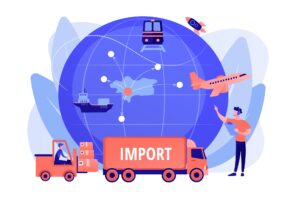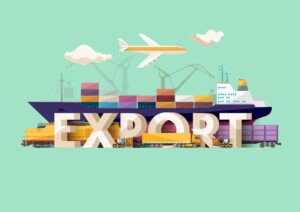OP Import Export Business Ideas for Sellers in India
Harsh Dhawan Export Experts Global OP Import Export Business Ideas for Sellers in India OP Import Export Business Ideas..
Import and export refer to a country’s international trading with other countries. The term import denotes international trade in which a country purchases goods and services from another country, whereas export denotes international trade in which a country sells goods and services to other countries.

Import and export processes are critical for countries to exist because no country possesses all of the resources it requires to survive. As a result, countries must rely on other countries for commodities and services they lack.
For example, the United States of America relies on countries such as Iran, Kuwait, and the United Arab Emirates, among others, and the United States’ principal exports are computers, mineral fuels, and electrical equipment, among others.
You will learn about both import and export, as well as the fundamental differences between the two, in this post.
Import refers to the acquisition of commodities and services from other countries that a country does not have in order to use in its own country. The government either uses the commodities and services purchased from other countries for public welfare or resells them on the domestic market.

Imports of goods and services have a direct effect on the country’s economy. Import commerce is higher when the economy is weak. As a result of the huge import of goods, a large amount of money leaves the country.
Many countries, including the United States, rely on middle eastern countries for crude oil and fuel, and these countries are getting wealthy as a result of their high export rates.
Selling oil to foreign countries generates more revenue for the economy. As a result, countries strive to achieve a balance between import and export in order to reduce the economic burden. It is, however, difficult for governments to attain.
Importing goods and services is normally avoided by a country, which tries to produce as much as possible at home. Only items that are either impossible to produce in the home nation (such as crude oil) or prove to be prohibitively expensive to manufacture in the home country are imported from other countries.
1) Inquiring about the goods on the global market: Importing begins with a search of the worldwide marketplace. Trade groups and trade directories, for example, can provide this information. Finally, inquire about the rate and delivery terms and conditions with the companies who export the goods you need to export.
2) Obtaining an Import License: The importer must now obtain an import licence. There are some commodities that require an importing licence and others that do not. It is necessary to know whether or not a licence is required, as well as how to obtain one.
3) How to Get Foreign Money: The next step is to obtain money from the country from which they wish to import products.
4) Ordering: Contact the exporters and place an order. Your order must include specific details on the product’s colour, design, number, and so on.
5) A letter of credit is a document that establishes a line of credit It’s a crucial stage in the import process. It protects you from troubles in the future. The bank issues you a letter of credit, which establishes your reputation. The letter of credit verifies your identity as well as the order’s terms and conditions.
6) A shipping receipt with the following information: Your exporter will provide you a receipt with details on the shipping, including the vessel name, invoice number, and description of items despatched, among other things.
7) Import documents for retirement: Import documents are provided to the bank for further action based on the products’ delivery.
8) Taking delivery of the package: The delivery officer hands over the export documentation to you.
9) Clearance and discharge from customs: Customs clearance is the final and most time-consuming step in the import process. To obtain a hold of the products imported, you must complete a long list of legal requirements.
Export refers to the sale of goods and services produced in one country to other ones. A country normally exports the items that it has in plenty to other countries. A country’s export trade is beneficial. It benefits and strengthens the economy.
A good economy is one in which a country exports more and imports less. Country must pool their resources in order to purchase goods that cannot be produced in their own countries. India, for example, is well-known for exporting IT personnel all over the world.
Many countries, such as the United States, import Indian IT services. The export of services benefits the country’s economy.
Countries attempt to export more than they import in order to keep more money in the country rather than sending it abroad. A strong economy is one in which exports outnumber imports.
1) Getting an enquiry and sending a quote: Buyers make requests for information to all possible sellers. The seller is required to give an order quotation, and the buyer accepts the seller’s proposal that suits him or is the lowest market price.
2) Order confirmation: If the buyer approves of your order, he will give you an order confirmation. The receipt contains order-related information.
3) Enquiring about the credibility of the buyer: In this phase, the seller inquires about the buyer’s trustworthiness and requests that the buyer send a letter of credit so that the order can be processed.
4) Obtaining an export licence: In order to export goods, an exporter must first obtain an export licence.
5) Obtaining pre-shipment financing: The exporter seeks pre-shipment financing from a bank or financial institution in order to complete the manufacturing process.
6) Production: The goods are produced in accordance with the importer’s specifications.
7) Inspection of the items created: After the first batch of goods is produced, the goods are inspected to ensure that they are of good quality. If there is a problem, the manufacturing process is altered.
8) Origin Certificate: The importer receives a certificate of origin, which certifies that the items were made in the country.
9) Making a shipment space reservation with the exporting company: In order to deliver items to your seller, you must use the services of a shipping company. You must make an advance reservation with the shipping business and inform them of the type of goods you wish to export, the volume of items, the date of shipment, and the delivery location, among other things.
10) Preparing and packing your order to send to the shipping company: When your order is complete. You must package the items so that they do not become damaged during shipment, and you must provide the destination address and nature of the goods on the packing.
11) Obtain insurance: When your items are in transit, you may be assured that natural disasters or accidents will not occur. As a result, in order to avoid future losses, you must insure the goods.
12) Customs clearance: Obtain customs clearance from your consumers so that your items can be delivered to the buyer without delay.
13) Obtain a receipt from a friend: When the port supervisor loads cargo, he generates a mate’s receipt.
14) Create an invoice: once the goods have been delivered. The next thing you should do is generate an invoice to submit to the buyer right away.
15) Payment: It is received once the goods have been delivered to the buyer. Following that, you must get all relevant documents, such as an invoice, a bill of lading, a certificate of origin, and a letter of credit, among others. In exchange for a bill, these documents are handed to the seller.
All countries’ import and export processes are significant. To boost the economy, countries must export things that they cannot manufacture and buy products. However, in order to maintain an upward economic trend, every country ensures that it exports more than it imports.
Importing and exporting procedures can be carried out in one of two ways: directly or indirectly. Both importing and exporting firms participate in the indirect process and carry out the entire process on their own, while intermediate firms carry out the entire process with little or no interaction between the participating enterprises.
Harsh Dhawan Export Experts Global OP Import Export Business Ideas for Sellers in India OP Import Export Business Ideas..
Harsh Dhawan Export Experts Global Which is the Best Academy in India for Import-Export Training ? Which is the Best Academy..
Harsh Dhawan Export Experts Global What is Import Export Business? What is Import Export Business? Let’s break this down step-by-step..
